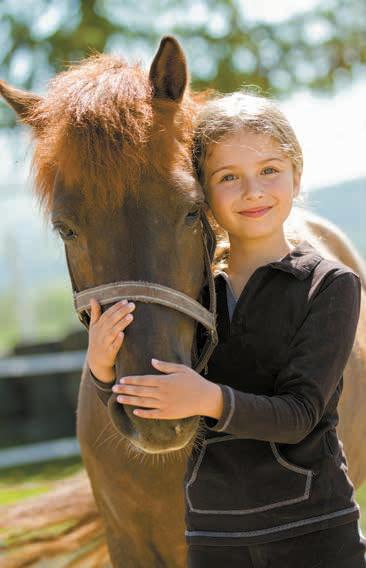
5 minute read
PET HAPPY
gorilla/AdobeStock.com
As any parent whose child has begged long and hard for a puppy or kitty can testify, animals are close to children’s hearts. Up to 90 percent of kids are lucky enough to live with a pet at some point in their childhood, and studies show the eff ects can be profound for their health, character development and well-being.
Kids and pets seem to share a deep and special bond. “Kids oft en recognize a kindred spirit in animals, especially pets. Like children, pets are cared for and nurtured in families by big people who get to make the rules,” says Gail F. Melson, Ph.D., professor emeritus of developmental studies at Purdue University and the author of Why the Wild Th ings Are: Animals in the Lives of Children.
In one of Melson’s studies, 40 percent of 5-year-olds said that they turn to their pets when they feel sad, angry or have a secret to share. Children with pets demonstrate more empathy toward their peers and are less anxious and withdrawn than children without pets, her research shows. A University of Cambridge (UK) study reported that kids were happier with their dogs and cats than with their brothers and sisters. PETS ENHANCE KIDS’ HEALTH. A study by UK’s Warwick University found that children with pets had more robust immune systems and attended school an extra nine days on average each year compared to those without pets. Early exposure can be optimal: Babies living in homes with two or more dogs and cats are less than half as likely by age 7 to develop reactions to indoor and outdoor allergens like pet dander, dust mites and ragweed, reports a Medical College of Georgia study.
Pets can have a measurable impact on children with special conditions. In a University of Massachusetts Medical School study of young people with Type 1 diabetes published in PLOS ONE, those that actively helped care for family pets were 2.5 times more likely to have well-controlled blood sugar levels, perhaps by learning the importance of daily routines. In families with an autistic child, owning a dog reduces stress and signifi cantly improves interactions, benefi ts that grow over time, report UK University of Lincoln researchers. PETS BUILD SOCIAL SKILLS. According to a large American Humane study, small pets like guinea pigs and reptiles in third- and fourth-grade classrooms improve students’ levels of communication, cooperation, responsibility, empathy, engagement and self-control. Pets can also train kids to set boundaries. Growing up in Verona, Wisconsin, twins McKenna and Samara Fagan became skillful at stopping their 70-pound golden retrievers and great Pyrenees from jumping on them, stealing their toys or persisting aft er a petting period had concluded. “As girls, they learned how to create boundaries not just with words, but also with body language and energy,” says their mother, Tia Fagan, a certifi ed conscious parenting and authenticity coach. Now, she says, the 20-year-olds know “how to create and hold healthy boundaries with people.” PETS TEACH RESPONSIBILITY. “A child who knows that every day they will need to walk the dog (if it’s safe), feed the dog (with guidance) or even scoop the yard, will thrive on the routine of care and oft en will feel a confi dence boost because they are taking care of their dog. Th is is empowering for kids who may not have much control over other things in their lives,” says Antoinette Martin of Cornelius, North Carolina, head veterinarian with the online vet locator HelloRalphie.com.
How Animals Help Kids Thrive
by Ronica O’Hara


PETS TEACH THE CYCLES OF LIFE.
Because pets have shorter life spans than humans, surveys indicate that about 80 percent of children first experience death when a beloved pet dies, offering a teachable moment for the whole family, says Melson. Veterinarian Michelle Burch’s 3-year-old daughter grieved when the family dog died, but the child was encouraged to express her sadness and was helped by the award-winning book Dog Heaven, by Cynthia Rylant. A year later, “She loves to bring up her dog Baxter to strangers and how he is in dog heaven, but she knows that not all animals will stay on Earth forever,” says Burch, veterinarian for the pet insurance site SafeHounds.com.
Difficult as the grief is, it’s still worth it, says Fagan. “Our pets have taught my children that to give and receive love unconditionally is the greatest gift of all and is worth the sadness and pain we feel when they pass.”
Natural health writer Ronica O’Hara can be reached at OHaraRonica@gmail.com.
The Practical Side of Family Pets
Evaluate the commitment. “It’s important to remember that taking care of pets is expensive and time consuming, and you’re making a commitment to the pet for the duration of their life,” cautions Jennifer Coates, DVM, an advisory board member of Pet News Daily. “Fostering is a great alternative if pet adoption sounds like more than you can handle. Children can also volunteer at some animal shelters (often when accompanied by a parent), allowing them to experience some of the benefits of caring for animals without the long-term commitment.” Pick a child-friendly dog or cat. The American Kennel Society puts Labrador retrievers, bulldogs, golden retrievers and beagles at the top of their best family dog list. For cats, birman, ragdoll and Himalayan breeds are recommended as calm choices for kids by PetMD.com. Consider improving an animal’s life by taking home a shelter or rescue dog or cat. Shelter workers can help select a family-friendly choice. Consider other species. Smaller animals with fewer care demands may be a strategy if house space is limited or if a child needs to grow into responsibilities. Animals that can delight and teach include tropical fish, turtles, rabbits, birds, hamsters and lizards. Mae Waugh Barrios’ three children enjoy feeding, watering and collecting the eggs from the family’s four chickens every day at their Holliston, Massachusetts, home. “Not only do our farm-fresh eggs provide my family and my children with the best nutrition, it’s also been a lesson in symbiotic relationships. Because we give such good care to our chickens, they show their appreciation by providing us with delicious eggs,” says Barrios, who blogs at RaisingEmergingBilinguals.com. Train children about safety around dogs. It’s a natural impulse for younger children to run up excitedly to a dog and try to touch it, but this can create fear in the animal and raise the danger of an aggressive response. Instead, teach a child to ask permission of the adult handling the dog, and then to approach it slowly and calmly, letting it smell the back of the downward hand before touching it.







